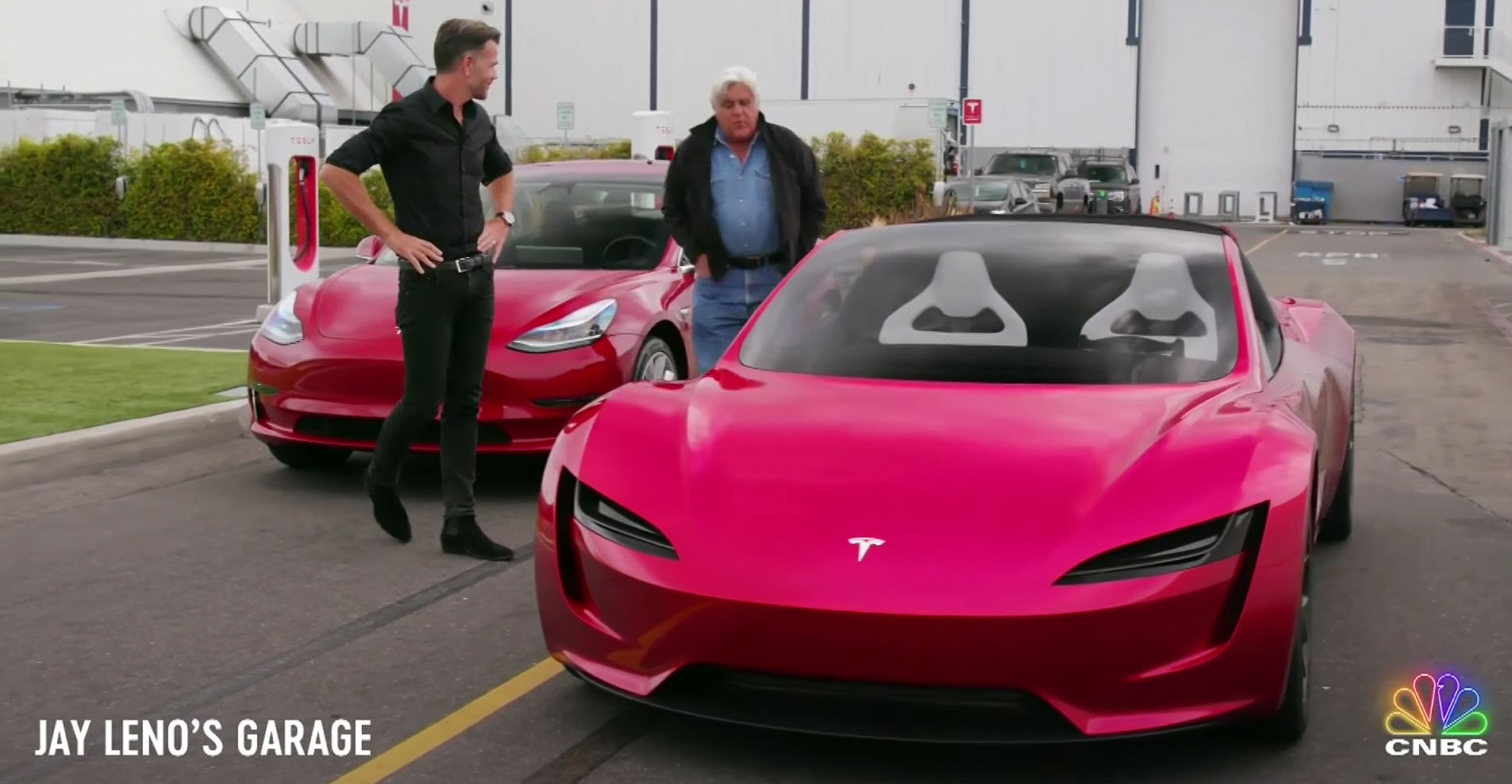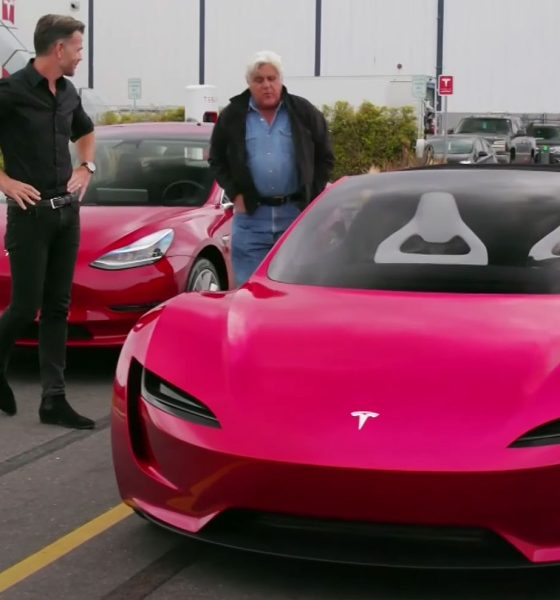

News
Tesla’s next-gen roadster to take spotlight on upcoming episode of Jay Leno’s Garage
The next-generation Tesla Roadster is coming to Jay Leno’s Garage for this Thursday’s upcoming episode. A preview of the all-electric supercar’s segment was teased on CNBC this Friday, which featured the iconic talk show host talking about the next-gen Roadster with Tesla’s Chief Designer Franz von Holzhausen.
This would not be the first time that the veteran talk show host would feature a Tesla in his show. Leno also did a pretty extensive segment on the Tesla Model S back in 2012, where he discussed the design, performance, and features of the electric family sedan. Franz von Holzhausen also joined the veteran talk show host then, providing a background on the development and capabilities of the Model S.
The next-generation Roadster is Tesla’s upcoming halo car, a vehicle designed to showcase the ultimate capabilities of the company. Elon Musk shocked the automotive world with the specs of the supercar when it was unveiled last year, with its 0-60 mph time of 1.9 seconds, top speed of over 250 mph, 200 kWh battery, and range of 620 miles per charge. Inasmuch as these figures are nothing short of insane, Musk mentioned during the unveiling, and in subsequent tweets over the past few months, that these specs were actually true of the next-gen Roadster’s base model. Considering that there will also be a “SpaceX option package” for the vehicle, there is a very good chance that the specs Tesla announced last year for the all-electric supercar were actually conservative.
The next-gen Roadster is expected to start production sometime in 2020, but Elon Musk has already been dropping some hints about the vehicle’s capabilities every so often. A recent interview with noted YouTube tech reviewer Marques Brownlee, better known as MKBHD, saw Elon Musk discussing several aspects of the Roadster, including its lack of side mirrors, its space, and its range. Musk even addressed the company’s Track Mode, which is set to make a debut on the Model 3 Performance.
One of the things that surprised people with the next-gen Roadster was its 200 kWh battery, particularly since its 620-mile range is pretty much unheard of in an electric car of its class. Even the Rimac C_Two, an upcoming all-electric hypercar that costs $2.1 million, is listed with a 400-mile range — roughly 35% less than the range of the next-gen Roadster. Musk noted in his interview that the next-gen Roadster’s 620-mile range could be accomplished even with the company’s current technology, though it would likely increase the volume of the Model S P100D’s battery pack by 80%.
More details about the next-gen Tesla Roadster would most likely be revealed in the upcoming episode of Jay Leno’s Garage, particularly since the veteran talk show host has been largely supportive of Tesla over the years. Back in 2016, Leno noted in a segment on CNBC that Americans should be supportive of the California-based company.
“We live in a world now where every year, you lose about 5% of the new car companies. In the mid-teens, there were 350 car companies in the United States. Every year since then, two or three of them dropped out. I mean, just in my lifetime, we’ve lost Oldsmobile, we’ve lost Pontiac, we’ve lost Saturn. There’s a whole bunch that just disappeared.
“So here comes a brand new car company, so that’s impressive. It’s a tough business to get into; and the fact that Tesla is making a go of it and quite successfully, I think is impressive and should be applauded. We’re becoming like the British — we like noble failures. I would watch, listen to these radio talk shows just tear Tesla apart; and I go, ‘Here’s a guy, building an American car in America, using American labor. Why are you not rooting for it to be successful? Why do you wish it would fail?’ I don’t quite understand.”
Watch a preview of the next-gen Roadster’s segment in the upcoming episode of Jay Leno’s Garage in the video below.

Elon Musk
Elon Musk and Tesla AI Director share insights after empty driver seat Robotaxi rides
The executives’ unoccupied tests hint at the rapid progress of Tesla’s unsupervised Robotaxi efforts.

Tesla CEO Elon Musk and AI Director Ashok Elluswamy celebrated Christmas Eve by sharing personal experiences with Robotaxi vehicles that had no safety monitor or occupant in the driver’s seat. Musk described the system’s “perfect driving” around Austin, while Elluswamy posted video from the back seat, calling it “an amazing experience.”
The executives’ unoccupied tests hint at the rapid progress of Tesla’s unsupervised Robotaxi efforts.
Elon and Ashok’s firsthand Robotaxi insights
Prior to Musk and the Tesla AI Director’s posts, sightings of unmanned Teslas navigating public roads were widely shared on social media. One such vehicle was spotted in Austin, Texas, which Elon Musk acknowleged by stating that “Testing is underway with no occupants in the car.”
Based on his Christmas Eve post, Musk seemed to have tested an unmanned Tesla himself. “A Tesla with no safety monitor in the car and me sitting in the passenger seat took me all around Austin on Sunday with perfect driving,” Musk wrote in his post.
Elluswamy responded with a 2-minute video showing himself in the rear of an unmanned Tesla. The video featured the vehicle’s empty front seats, as well as its smooth handling through real-world traffic. He captioned his video with the words, “It’s an amazing experience!”
Towards Unsupervised operations
During an xAI Hackathon earlier this month, Elon Musk mentioned that Tesla owed be removing Safety Monitors from its Robotaxis in Austin in just three weeks. “Unsupervised is pretty much solved at this point. So there will be Tesla Robotaxis operating in Austin with no one in them. Not even anyone in the passenger seat in about three weeks,” he said. Musk echoed similar estimates at the 2025 Annual Shareholder Meeting and the Q3 2025 earnings call.
Considering the insights that were posted Musk and Elluswamy, it does appear that Tesla is working hard towards operating its Robotaxis with no safety monitors. This is quite impressive considering that the service was launched just earlier this year.
Elon Musk
Starlink passes 9 million active customers just weeks after hitting 8 million
The milestone highlights the accelerating growth of Starlink, which has now been adding over 20,000 new users per day.

SpaceX’s Starlink satellite internet service has continued its rapid global expansion, surpassing 9 million active customers just weeks after crossing the 8 million mark.
The milestone highlights the accelerating growth of Starlink, which has now been adding over 20,000 new users per day.
9 million customers
In a post on X, SpaceX stated that Starlink now serves over 9 million active users across 155 countries, territories, and markets. The company reached 8 million customers in early November, meaning it added roughly 1 million subscribers in under seven weeks, or about 21,275 new users on average per day.
“Starlink is connecting more than 9M active customers with high-speed internet across 155 countries, territories, and many other markets,” Starlink wrote in a post on its official X account. SpaceX President Gwynne Shotwell also celebrated the milestone on X. “A huge thank you to all of our customers and congrats to the Starlink team for such an incredible product,” she wrote.
That growth rate reflects both rising demand for broadband in underserved regions and Starlink’s expanding satellite constellation, which now includes more than 9,000 low-Earth-orbit satellites designed to deliver high-speed, low-latency internet worldwide.
Starlink’s momentum
Starlink’s momentum has been building up. SpaceX reported 4.6 million Starlink customers in December 2024, followed by 7 million by August 2025, and 8 million customers in November. Independent data also suggests Starlink usage is rising sharply, with Cloudflare reporting that global web traffic from Starlink users more than doubled in 2025, as noted in an Insider report.
Starlink’s momentum is increasingly tied to SpaceX’s broader financial outlook. Elon Musk has said the satellite network is “by far” the company’s largest revenue driver, and reports suggest SpaceX may be positioning itself for an initial public offering as soon as next year, with valuations estimated as high as $1.5 trillion. Musk has also suggested in the past that Starlink could have its own IPO in the future.
News
NVIDIA Director of Robotics: Tesla FSD v14 is the first AI to pass the “Physical Turing Test”
After testing FSD v14, Fan stated that his experience with FSD felt magical at first, but it soon started to feel like a routine.

NVIDIA Director of Robotics Jim Fan has praised Tesla’s Full Self-Driving (Supervised) v14 as the first AI to pass what he described as a “Physical Turing Test.”
After testing FSD v14, Fan stated that his experience with FSD felt magical at first, but it soon started to feel like a routine. And just like smartphones today, removing it now would “actively hurt.”
Jim Fan’s hands-on FSD v14 impressions
Fan, a leading researcher in embodied AI who is currently solving Physical AI at NVIDIA and spearheading the company’s Project GR00T initiative, noted that he actually was late to the Tesla game. He was, however, one of the first to try out FSD v14.
“I was very late to own a Tesla but among the earliest to try out FSD v14. It’s perhaps the first time I experience an AI that passes the Physical Turing Test: after a long day at work, you press a button, lay back, and couldn’t tell if a neural net or a human drove you home,” Fan wrote in a post on X.
Fan added: “Despite knowing exactly how robot learning works, I still find it magical watching the steering wheel turn by itself. First it feels surreal, next it becomes routine. Then, like the smartphone, taking it away actively hurts. This is how humanity gets rewired and glued to god-like technologies.”
The Physical Turing Test
The original Turing Test was conceived by Alan Turing in 1950, and it was aimed at determining if a machine could exhibit behavior that is equivalent to or indistinguishable from a human. By focusing on text-based conversations, the original Turing Test set a high bar for natural language processing and machine learning.
This test has been passed by today’s large language models. However, the capability to converse in a humanlike manner is a completely different challenge from performing real-world problem-solving or physical interactions. Thus, Fan introduced the Physical Turing Test, which challenges AI systems to demonstrate intelligence through physical actions.
Based on Fan’s comments, Tesla has demonstrated these intelligent physical actions with FSD v14. Elon Musk agreed with the NVIDIA executive, stating in a post on X that with FSD v14, “you can sense the sentience maturing.” Musk also praised Tesla AI, calling it the best “real-world AI” today.








